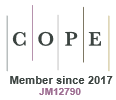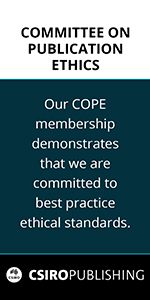Latest
These articles are the latest published in the journal. Australian Mammalogy is published under a continuous publication model. More information is available on our Continuous Publication page.
AM24052Taxonomic tangles posed by human association – the urgent need for an evidence-based review of dingo and domestic dog taxonomy and nomenclature
 , Mike Letnic, Euan G. Ritchie, Justin W. Adams, Mathew S. Crowther
, Mike Letnic, Euan G. Ritchie, Justin W. Adams, Mathew S. Crowther  , Christopher R. Dickman
, Christopher R. Dickman  , Melanie Fillios, Jack Pascoe, Bradley P. Smith
, Melanie Fillios, Jack Pascoe, Bradley P. Smith  and Thomas M. Newsome
and Thomas M. Newsome
The naming and species status of dingoes is hotly debated and has serious policy implications. We outline recent advances in our knowledge of the distinctiveness of dingoes from domestic dogs, highlighting how dingoes are on a different evolutionary path. Resolving debate about the status and name of dingoes will likely require an independent review by a scientific organisation with broad community consultation, similar to the review carried out for Mexican wolves (Canis lupus baileyi) and red wolves (Canis rufus).
AM24052 Abstract | AM24052 Full Text | AM24052PDF (1.2 MB) Open Access Article
AM25028The bold and the biased: the influence of behaviour on capture probability in woylies (Bettongia penicillata ogilbyi)
Behaviour-driven capture biases (where consistent differences in behaviour among individuals affect their probability of being captured) have the potential to confound studies of animal behaviour and population ecology. This study explicitly tests whether there is any correlation between agitation behaviour and capture probability in wild woylies, finding no evidence for an effect. This finding suggests that studies of woylies using live trapping are unlikely to be confounded by behaviour-driven sampling biases arising from this particular trait.
AM25028 Abstract | AM25028 Full Text | AM25028PDF (984 KB) | AM25028Supplementary Material (132 KB) Open Access Article
AM25025Whisker morphology and distribution in wombats: a comparative anatomical study
Whiskers can provide information regarding species behaviour. We compared the whiskers of bare-nosed (Vombatus ursinus) and southern hairy-nosed (Lasiorhinus latifrons) wombats. Based on our findings, it is likely southern hairy-nosed wombats are more reliant on their whiskers for somatosensory information collection than bare-nosed wombats.
AM24028Environmental variables that influence platypus (Ornithorhynchus anatinus) eDNA detection: an insight into eDNA study design for platypus occupation
Understanding platypus distribution in challenging environments is crucial but difficult owing to their elusive nature and inaccessible habitats. We leveraged environmental DNA technology to detect platypuses across diverse conditions in Kosciuszko National Park, showing that eDNA can uncover platypuses in new high-altitude locations and is influenced by altitude, stream order, and seasonality. These findings highlight the potential of eDNA to improve wildlife monitoring, and underscore the need for refining eDNA survey designs to enhance viability and interpretation across different environmental variables.
This article belongs to the collection: Recent research on the platypus.
AM24028 Abstract | AM24028 Full Text | AM24028PDF (3.3 MB) Open Access Article
AM25009First evidence of aggressive interactions by native rakali towards invasive black rats
We document the first recorded evidence of a native rakali ambushing an invasive black rat in the natural environment. This observation offers unique evidence suggesting that rakali may be competitively dominant over invasive black rats. This finding provides ecological justification for the conservation and promotion of rakali as a potential natural predator of black rats as part of broader ecological restoration strategies building biotic resistance from native species. Video images by Margarita Goumas.
AM25009 Abstract | AM25009 Full Text | AM25009PDF (1.5 MB) | AM25009Supplementary Material (30.4 MB) Open Access Article
Predator–prey interactions are important in defining ecological food webs. Predation of northern quoll by Pilbara olive python is reported herein, two threatened native predators.
AM25013Local high concentration of Red Foxes (Vulpes vulpes) observed during lambing in northern New South Wales, Australia
Red foxes are a major predator of livestock and wildlife in Australia, yet their local behaviour during key farming events is not well understood. We documented an unusually high number of foxes – 21 in 1 h – drawn to a lambing event in northern New South Wales, with more appearing over the following days. This highlights how strongly foxes respond to lambing, with important implications for predator control and livestock protection during vulnerable periods.
AM25013 Abstract | AM25013 Full Text | AM25013PDF (1.5 MB) Open Access Article
AM24046The great divide: population comparison using 3D and 2D geometric morphometrics of Petaurus breviceps and Petaurus notatus along Australia’s eastern Great Dividing Range
The study examined skull size and shape of ‘sugar gliders’ (Petaurus breviceps and Petaurus notatus) to clarify their distribution in Australia. Significant differences were found between populations east, mid and west of the Great Dividing Range (GDR) in New South Wales. P. breviceps was absent from its previously described GDR range, being restricted to the eastern coastal zone south of the Brisbane Valley Barrier (BVB).
AM24046 Abstract | AM24046 Full Text | AM24046PDF (1.9 MB) | AM24046Supplementary Material (282 KB) Open Access Article
AM25006Home range and activity areas of foxes (Vulpes vulpes) in urban and peri-urban areas
This paper describes a new method of calculating the activity area of foxes based on a 5-day sliding window over a minimum period of 10 days that attempts to avoid overestimating the area of occupancy by using the area-corrected autocorrelated kernel density estimation (AKDEc) method.
AM25014The first confirmed grey-headed flying-fox (Pteropus poliocephalus) roost in western New South Wales, Australia
The grey-headed flying-fox typically occurs in temperate and subtropical regions of eastern and south-eastern Australia. We report an unusual account of grey-headed flying-foxes sustaining a roost in a semi-arid region of western New South Wales. Photographs by Matthew Mo and Trevor Bauer.
AM25014 Abstract | AM25014 Full Text | AM25014PDF (6.9 MB) Open Access Article
AM25001Notes on the fungal diets of four Antechinus species from south-eastern Australia
Fungal consumers play an important role in maintaining ecosystem health by dispersing mycorrhizal fungi, which forms symbiotic relationships with plants. Fungal dispersal is poorly understood within the Dasyuridae, with only 7 of the 61 Australian species identified as fungal consumers. This study provides the first evidence of fungal consumption by swamp antechinus (A. minimus) and mainland dusky antechinus (A. mimetes), and it is likely that there are many other dasyurids which disperse fungi. Photograph by Conor Nest.
AM25001 Abstract | AM25001 Full Text | AM25001PDF (791 KB) Open Access Article
AM24042Weathering Kangaroo Island’s extremes: insights into captures, health, and diet of introduced platypuses in the Rocky River
The introduced platypus population on Kangaroo Island offers a rare opportunity to examine resilience under extreme environmental pressures. Our study found lower capture rates than those two decades ago, along with shifts in diet composition and physiological markers following recent drought, bushfires, and floods. Although evidence of ongoing reproduction suggests persistence, these findings highlight both the vulnerability and adaptability of this isolated population, providing important insights to guide conservation efforts for freshwater species in increasingly variable environments.
This article belongs to the collection: Recent research on the platypus.
AM24042 Abstract | AM24042 Full Text | AM24042PDF (2.5 MB) Open Access Article
AM24047Recent roosting of little red flying-foxes (Pteropus scapulatus, Pteropodidae) at two sites in the South Coast region of New South Wales, Australia
 , Kylie Coutts-McClelland, Trista Kyriacou, Janine Davies, Gerardine Hawkins, Samara Wehmeyer, Lorraine Oliver, Samantha H. Yabsley, Jessica Meade and Justin A. Welbergen
, Kylie Coutts-McClelland, Trista Kyriacou, Janine Davies, Gerardine Hawkins, Samara Wehmeyer, Lorraine Oliver, Samantha H. Yabsley, Jessica Meade and Justin A. Welbergen 
Little red flying-fox (Pteropus scapulatus) colonies were recently observed in two locations on the South Coast of the New South Wales, a region in which roosting by this species is rarely observed. The colonies persisted for at least 25 days and comprised thousands of individuals. Photograph by Matthew Mo.
AM24047 Abstract | AM24047 Full Text | AM24047PDF (2.4 MB) Open Access Article
We describe a new northern record of the parma wallaby (Notamacropus parma) captured during a free-ranging dog trapping and collaring program in northern New South Wales, Australia.
AM25018 Abstract | AM25018 Full Text | AM25018PDF (1.6 MB) Open Access Article
Just Accepted
These articles have been peer reviewed and accepted for publication. They are still in production and have not been edited, so may differ from the final published form.
Feasibility of nocturnal thermal drone surveys for detecting endangered mahogany gliders (Petaurus gracilis) in tropical lowland woodlands
 , Yiyin Chang, Stephen Jackson and Conrad Hoskin
, Yiyin Chang, Stephen Jackson and Conrad Hoskin
Most Read
The Most Read ranking is based on the number of downloads in the last 60 days from papers published on the CSIRO PUBLISHING website within the last 12 months. Usage statistics are updated daily.
-
-
First evidence of aggressive interactions by native rakali towards invasive black rats
Australian Mammalogy 47 (2) -
Patterns of activity and travel by koalas in a disturbed urban landscape in Queensland
Australian Mammalogy 47 (1)Philippa Kirsten Tacla, Benjamin James Barth, Sean Ian FitzGibbon, Amber Kristen Gillett, William Anthony Ellis -
-
-
Local high concentration of Red Foxes (Vulpes vulpes) observed during lambing in northern New South Wales, Australia
Australian Mammalogy 47 (2)Deane A. Smith, Thomas Coldham, Paul D. Meek -
The first confirmed grey-headed flying-fox (Pteropus poliocephalus) roost in western New South Wales, Australia
Australian Mammalogy 47 (2) -
Factors contributing directly to platypus (Ornithorhynchus anatinus) mortality and implications for conserving populations in the wild
Australian Mammalogy 47 (1)Melody Serena, Geoff A. Williams, Jessica L. Thomas -
Assessing the detectability of a cryptic arboreal marsupial by using a novel survey approach
Australian Mammalogy 47 (2) -
A population viability analysis of K’gari (Fraser Island) wongari (dingoes)
Australian Mammalogy 47 (1) -
Notes on the fungal diets of four Antechinus species from south-eastern Australia
Australian Mammalogy 47 (2) -
Weathering Kangaroo Island’s extremes: insights into captures, health, and diet of introduced platypuses in the Rocky River
Australian Mammalogy 47 (2)Tahneal Hawke, Gilad Bino, Paris Hughes, Alice Hunter, Guido Parra Vergara, Jessica Clayton, Robert Ellis, Ryan Baring -
-
Thermal drones are highly effective for detecting elusive Bennett’s tree kangaroos (Dendrolagus bennettianus) in Australia’s tropical rainforests
Australian Mammalogy 47 (1)Emmeline Bernadette Barrett Norris, Johan Larson -
Most-northern record of parma wallaby (Notamacropus parma)
Australian Mammalogy 47 (2) -
-
Age determination in the platypus (Ornithorhynchus anatinus) using spur sheath and spur developmental stages: a review
Australian Mammalogy 46 (3)Tom Grant, Melody Serena, Geoff A. Williams, Peter Temple-Smith -
-
-
Collections
Collections are a curation of articles relevant to a topical research area
Discover key insights from the 2023 platypus symposium, held at the Australian Platypus Conservation Centre in this new Collection, ‘Recent research on the platypus.’ The symposium had the future of the platypus as its overarching theme and was open to all those working with this very special animal. ‘Recent research on the platypus’ brings together original papers, reviews, and research notes on a broad range of topics including on general biology, monitoring techniques, and pressing conservation issues.
Last Updated: 28 Jul 2025
After 48 years in print, Australian Mammalogy published its first online-only issue early 2020. To commemorate the occasion, the Australian Mammal Society council collated a virtual issue that includes our member’s choices of the most important publications over the lifetime of Australian Mammalogy. We hope you will enjoy this issue and look forward to a long future of multidisciplinary, highly influential research published in Australian Mammalogy.
Vera Weisbecker (President) and Ross Goldingay (Editor-in-Chief)
Last Updated: 10 Oct 2024









